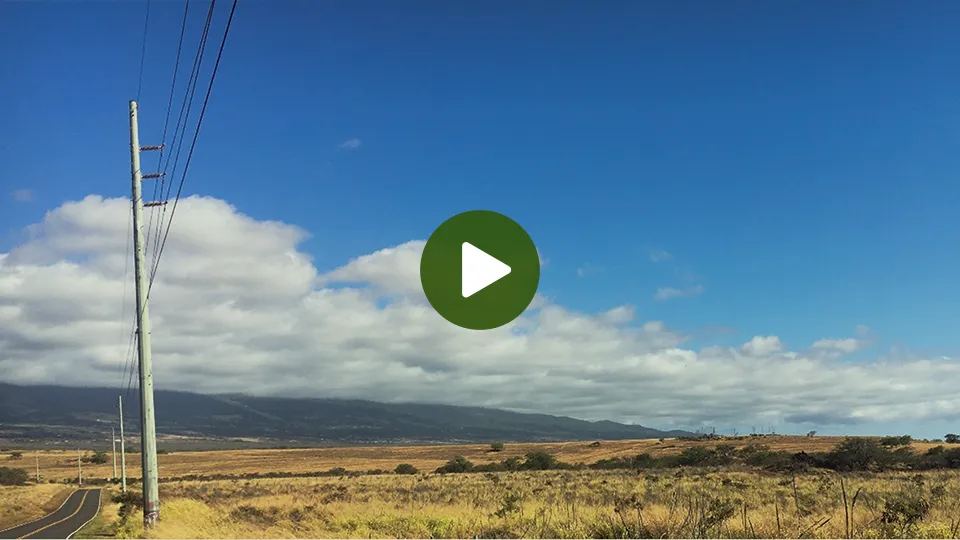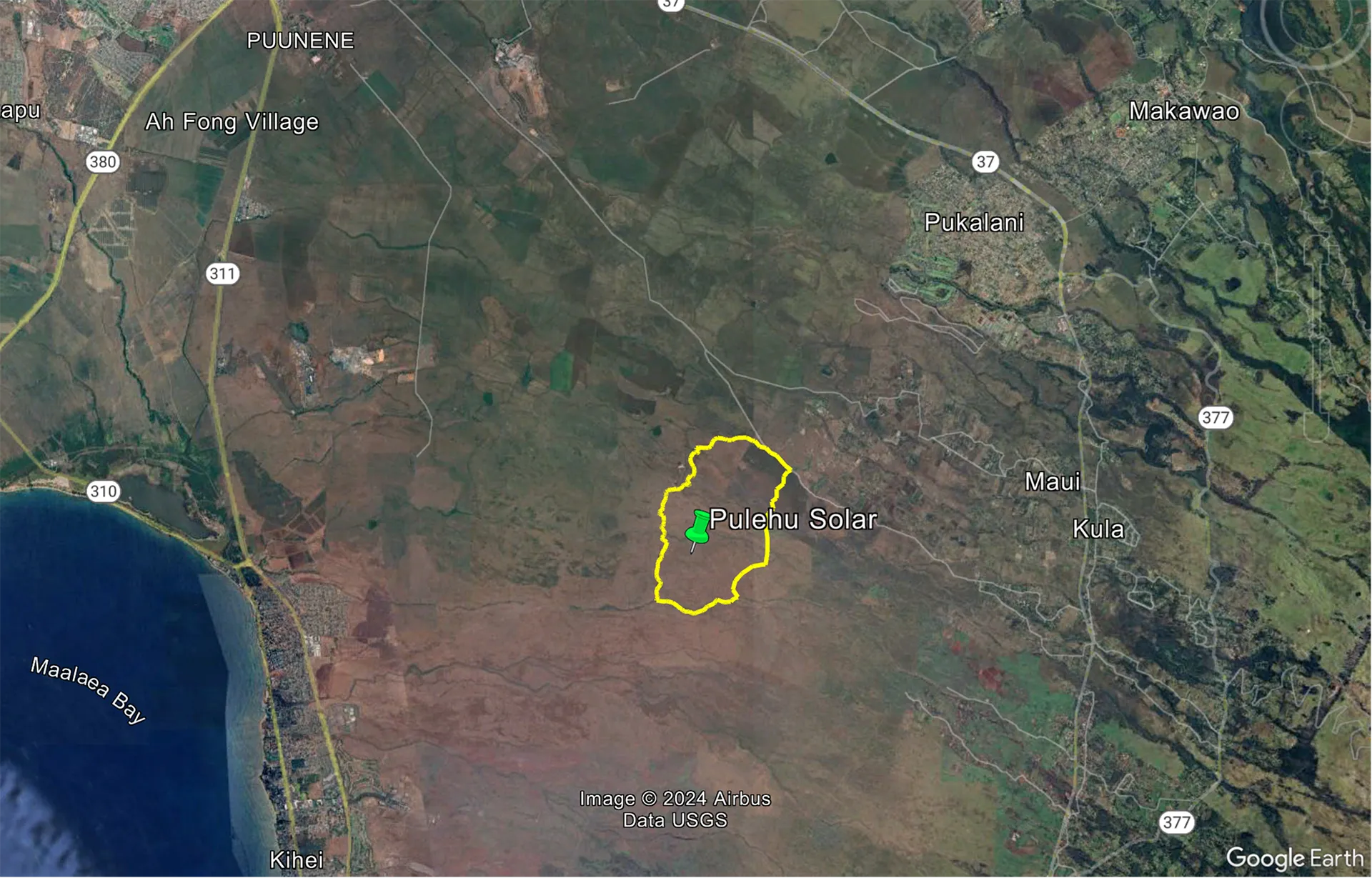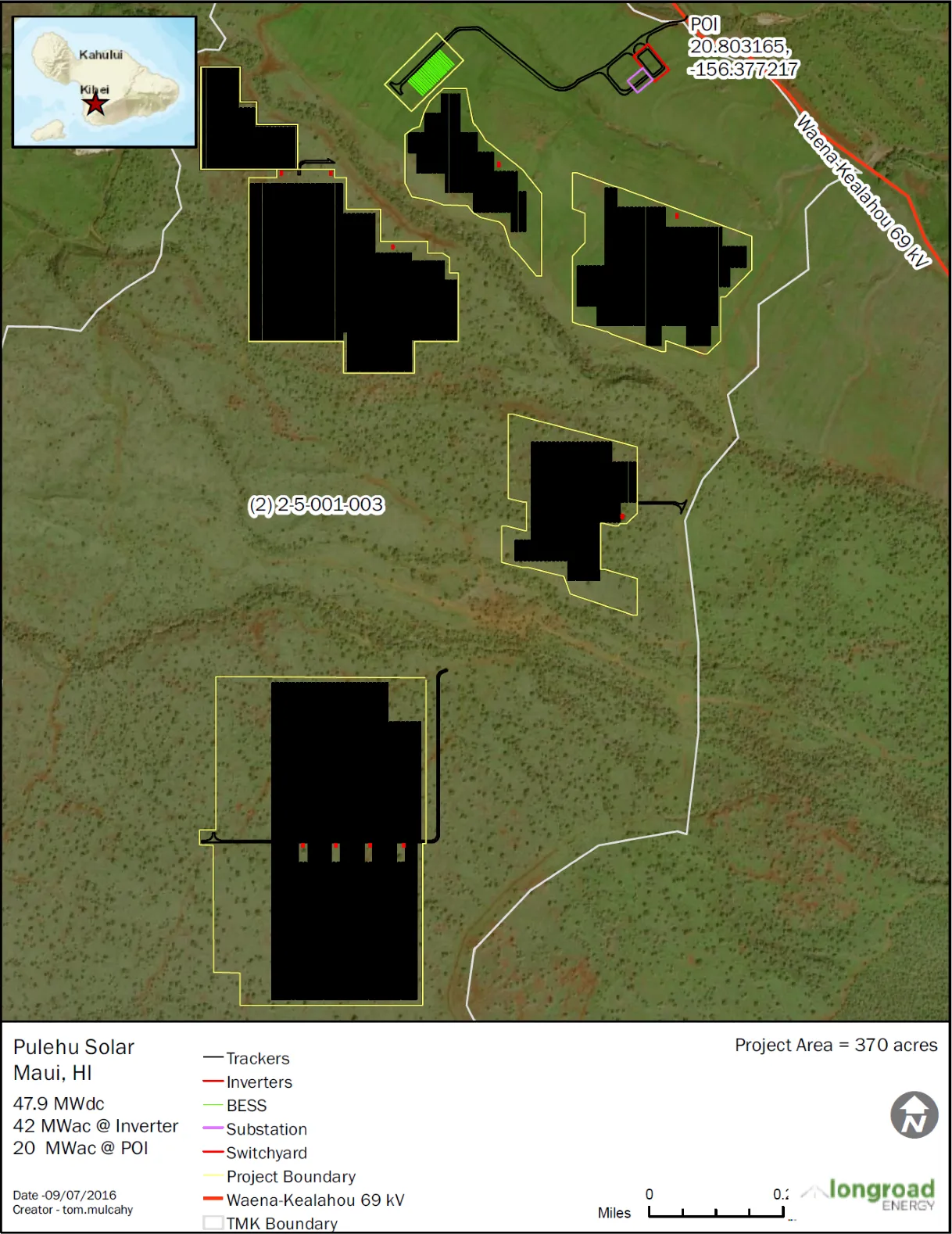Pūlehu Solar Project
The Pūlehu Solar project in lower Kula on Maui, was awarded in the Hawaiian Electric Stage 3 RFP. Previously postponed due to the global supply chain crisis, the project is now back on track to provide Maui with clean, renewable energy by 2027.
Development of the project has been successful, obtaining most of the needed permits and approvals, completing all studies and most engineering, and having strong community support. In the coming weeks and months, we will be reaching out to community members and stakeholders to share information and ideas for the project. We are also working with stakeholders to provide ongoing benefits to the community in areas wildfire mitigation, education in renewable energy and Hawaiian cultural resources.
Project Description
Longroad Energy is designing the Pūlehu Solar project to produce clean energy in Pūlehu, Maui. At 20 MW(ac), this project could produce up to 5% of the island’s electricity annually, enough to power about 15,000 local homes, enabling the utility to burn less fossil fuel and emit less greenhouse gasses. The project will also include an 80 MWh (4-hour) battery system to store solar energy during the day and provide power at night, and a new substation to connect to the Maui grid. Previously, the Pūlehu project was 40 MW(ac), but recent operational changes by the utility have limited the size of new projects to 20 MW.
The team at Longroad (previously as First Wind) worked successfully with local communities to develop 7 of Hawaii’s largest energy projects, including Kaheawa Wind above Ma‘alaea. At Pūlehu Solar, we are working with Haleakala Ranch to turn some of their less productive pasture land into low-cost clean energy for the island. The project would occupy 363 acres makai (west) of Pūlehu Road. The project would likely create more than 100 jobs during construction and another 1-2 long-term positions during operations. In conjunction with our contractors, we plan to prioritize hiring workers from Maui and the rest of the state, in the construction and operation of the project.
Project Schedule and Approvals
The following is an overview of the planned project schedule and a status list of the permits and approvals that will be required.

Anticipated Permit/Approvals:
| State | Agency | Status |
|---|---|---|
| Historic Preservation Review (HRS Chapter 6E) | State Historic Preservation Division (SHPD) | Approved in 2021. Submission of Management Plan in 2025. |
| National Pollutant Discharge Elimination System (NPDES) | State Department of Health (DOH) Clean Water Branch | Application in 2025 |
| Noise Permit | DOH Indoor and Radiological Health Branch | Application in 2025 |
| County | Agency | Status |
|---|---|---|
| County Special Use Permit | County of Maui Planning Department and Planning Commission | Approved in 2021. Request extension in 2024. |
| Building Permit | County of Maui Department of Public Works | Application in 2024 |
| Grading, Grubbing, and Stockpiling Permit | County of Maui Department of Public Works | Application in 2024 |
Potential Impacts
The positive impacts from a solar project are more clean, locally generated renewable energy, less fossil-fuel burning, less greenhouse gasses that contribute to climate change, and hopefully lower, more stabilized electricity prices. Because of the distance of the project from residential areas, most people who live in the general area will not see the project from their homes or experience any sound, visual or other impacts. The project is not expected to create significant impacts to archaeological resources, cultural practices, or any sensitive flora or fauna. Impacts to nearby views will be mitigated by siting some the project substation and battery system further away from Pūlehu Road and installing vegetative screening. During construction, which is anticipated to start in 2025, there will be some localized dust, noise and some additional traffic from construction vehicles, but the total duration of construction is expected to last about 12-18 months.
Based on studies, the project is not expected to create significant impacts to archaeological resources, cultural practices, or any sensitive flora or fauna. Longroad conducted an initial site assessment in 2017 which looked at archaeological, cultural, biological and other environmental resources, as well as potential impacts to drainage, traffic, view plan, and many other factors. The result was that the project will create minimal, if any, negative impacts to the on-site resources or the surrounding community.
To date, no sensitive resources or unique conditions have been identified that warrant special consideration in the siting process. The preliminary results of the due diligence efforts, in combination with the current land use classification and zoning designations underscore the suitability of the proposed site for a utility-scale solar facility. Based on the land use and zoning designations, the proposed solar project is consistent with state and county land use regulations, and no changes in the land use classification or zoning district would be required for project implementation. The project received approval of its archaeological assessment from the State Historic Preservation Division and received approval of its County Special Use Permit from the Maui Planning Commission.
Community Outreach Plan
This Community Outreach Plan focuses on work with community stakeholders, including our approach, our team, outreach to date, next steps, and a summary of our community benefits discussions to date. For information about the project itself and the plan for its development, permitting, hiring, impacts, construction and operation, please refer to the appropriate section of this page.
Our Approach
Longroad is a strong proponent of community outreach and is committed to sharing information about our planned energy projects and seeking community input that reflects the neighboring community voice, insight into cultural and environmental impacts and feedback on benefits and challenges. For every project we develop, we meet or talk with wth people that live, work or spend time around the project site, or who are stakeholders in other ways, such as having family history in the area or other kuleana in or around the location.
Ensuring that residents, especially the neighboring communities of the Project, are informed and engaged is a top priority. Neighboring communities and stakeholders will be provided timely information during all phases of the project, including the Power Purchase Agreement negotiation period, the permitting process periods, and before and during construction. Through outreach efforts with stakeholders, Longroad will:
- Share information about the plans for the project from development through construction and operation
- Ask for ideas and input that could help improve the project for the community
- Identify concerns about the project and discuss ways to solve or mitigate
- Discuss what additional benefits the project could provide to the community
- Identify a community contact person responsible for the Project development
Our Team
Longroad’s local team has extensive experience with community outreach for previous renewable energy projects developed from 2005 to 2015 by Longroad Energy and First Wind, including Kaheawa Wind, Kahuku Wind, Kawailoa Wind, Kawailoa Solar, Waipio Solar and Lanikuhana/Mililani II Solar. Longroad has established a reputation for engaging with community members early, being accountable in communicating, and listening to community input in order to modify projects to mitigate negative impacts. The community engagement team for the Project also includes consultants, Kawika McKeague (Principal at G70), Donalyn Dela Cruz (DDC Consulting), both of whom bring extensive local knowledge and many relationships community leaders, government officials and cultural practitioners in the affected communities. Members of the team are both kanaka (of Native Hawaiian descent) and keiki o ka ʻāina (from Hawaiʻi), who are vested in the improvement of Hawaiʻi’s future for generations to come.
Outreach to Date
Longroad began the process of community outreach regarding the Pūlehu project in 2017. We contacted and spoke with many people in and around the greater Pūlehunui and Kula areas, which we consider to be the “host community,” including individual residents, organizations, businesses, community leaders and government officials. We met with residents of Kula Meadows Homeowners Association, Kula Community Association, and with representatives of Waiohuli Homestead Association, Maui Tomorrow, Maui Economic Development Board, Office of Hawaiian Affairs, Haleakala Ranch, Kaonoulu Ranch, Aha Moku ‘o Maui and many other organizations. We also conducted public community meetings online and over Akaku which were open to anyone on the island. We also identified other people who could provide feedback and suggestions about history, impacts to the landscape and cultural significance, including initial engagement with identifiable loea (practitioners), kumu (cultural teachers) or kupuʻāina (individuals with genealogical ties to the area) as a means to introduce the project as a concept and to seek to understand the perspectives, beliefs, and range of opportunities and concerns that these individuals may have regarding the project area and its historical/cultural context; its resources; and/or the nature of the project’s perceived impact on those elements.
So far, community reaction to this project has been mostly positive or neutral. The majority of community members’ comments have expressed support or acceptance about renewable energy generally and a feeling that this general location would be suitable for solar, with lower agricultural productivity and minimal competing uses. A few community members expressed concerns about potential impacts, particularly wildfire risk to the Kula area and visibility of the Substation and Battery System from Pūlehu Road. Based on these concerns, Longroad increased the fire break width along the Kula-facing side of the project and added fire suppression facilities to the project. The only direct opposition to the Project was from a few residents who lived in the nearby Kula Meadows housing development. Longroad worked extensively with these residents and re-designed the project to mitigate their concerns about view impacts by relocating the BESS and substation further from Pūlehu Road and planning additional vegetative screening facing their direction. This also addressed one of the concerns from other residents in the broader area. Ultimately, a majority of Kula Meadows residents voted in support of the project.
When the project was postponed in 2022, the Longroad team notified our community contacts, and explained that we hoped to resume the project once it was selected to the final award group in the Stage 3 RFP. Now that the project has been awarded, we will be resuming active community outreach work, reaching out to stakeholders and continuing discussions around community benefits. We look forward to reengaging with Maui stakeholders over the next few weeks and months. If you would like to be included in future updates, please join our email list. If you have ideas for other organizations to include in our outreach, please contact us any time.
Next Steps in Outreach
In 2024, we plan to do the following:
- Reach out to existing stakeholders via email or phone to provide update on the project
- Publish updated project web page with information on the project
- Sharing contact information so that interested people can easily contact us about the project
- Publicize and conduct online and/or in-person community meetings about the project
- Expand the list of current contacts to engage more community members in planning efforts
- Conduct individual conversations with individuals, community groups, organizations, businesses, stakeholders, and government officials
- Publish and maintain Project Website
- Continue conversations with stakeholders on developing community benefits
In 2025, leading up to construction of the project, we plan to:
- Inform community members about pre-construction and construction activities including potential impacts to the community
- Maintain open method of communication so that community concerns can be addressed
- Finalize community benefits commitments and agreements
Once the project is completed in 2027, we will maintain an ongoing communication channel throughout operations to receive and share info with community.
Community Benefits
We believe the additional benefits that a project provides to the local community should be designed in consultation with community members. In many conversations with stakeholders about the Project, priority areas for the surrounding community fall into four areas: wildfire mitigation, natural resource management, Native Hawaiian cultural awareness and education about renewable energy. Longroad has already made contributions and commitments over the past several years to organizations that work in these areas, at the recommendation of community members, including Maui Economic Development Board ($10,000 committed) to conduct educational programs about renewable energy in local schools, and Maui and Technology Center ($5,000 donated) for its cultural awareness programs in South Maui.
Looking ahead, Longroad is committed to providing at least $60,000 annually in community benefits for the Project. A documented community benefits package detailing the intended distribution of funds is currently being developed for the Project. The commitment areas below have been proposed by members of the surrounding community in many meetings and conversations to date, and these important conversations are still ongoing. Some specific areas have included installing a water tank that can be used as a dip-tank for fire-fighting helicopters as a resource to fight fires in the area, and contributing to dryland forest restoration. At the request of community members, the specific benefits are still being discussed with stakeholders and require further discussion before being finalized and formalized in a community benefits agreement (CBA) or similar documents. If you have other ideas for benefits, please contact us.
| Commitment Area | Percentage |
|---|---|
| Wildfire mitigation | 25% |
| Natural resource management | 25% |
| Native Hawaiian cultural programs | 25% |
| Education in clean energy | 25% |
| TOTAL | 100% |
Additional Plan Details
Elements of Longroad’s Community Outreach Plan include the following:
Individual and Small-Group Stakeholder Conversations
Longroad has already engaged in dozens of individual and small group conversations with community members, including residents, kupuna, business owners, nonprofit groups, cultural practitioners and government officials. Outreach is made through email, phone and word-of-mouth, to engage with individual stakeholders. Conversations often occur in-person, over the phone or online videoconference, and occasionally via email. Questions, concerns and comments are logged for later follow up as needed and generate ideas for benefits to be discussed more broadly with communities.
Community Meetings: Virtually accessible
Longroad will plan both in-person and virtual community meetings to ensure that the community is well informed and has an opportunity to provide feedback. There will be advanced information shared in preparation with key stakeholders. To ensure widespread accessibility, community meetings will be televised on Nā Leo TV. Options to attend the meeting virtually will also be made available to allow for live engagement.
Notification of Meetings
Longroad will advertise in the community papers about any community meetings two weeks in advance of the meeting in community publications. This is in addition to email notifications to stakeholders and those who have signed up for updates. Media advisories regarding public meetings will be issued to O‘ahu and statewide media, which includes but is not limited to: Honolulu Star-Advertiser, Civil Beat, Hawai‘i News Now, KHON2 News, and KITV News.
Educational Kiosk
Longroad proposes to set up an educational kiosk, at or near the Project site, where people can access information about the project on their own time. This educational kiosk will be advertised in the local media and in mailings to share with residents that it is available. This kiosk would be designed in collaboration with Hawaiian Electric as a demonstration site that highlights renewable energy needs and the benefits the Project provides in that community.
Website: longroadenergy.com/pūlehu
Longroad will post information regarding the project to this website – including this communication plan. The website will offer an option to sign up for updated information and have an email address for inquiries. Emails will then be added to the distribution list that will be another aspect of ongoing public communication.
Email: pūlehusolar@longroadenergy.com
Longroad will provide email updates prior to meetings, and periodically, to a distribution list of stakeholders. We have also established an email address, so that inquiries regarding the Project can be directed here.
Public Comments
Supportive and opposing comments and feedback will be gathered throughout the outreach process. These will be compiled and filed with the Public Utilities Commission.
Contact
For more information, sign up below to be on our project email list.
"*" indicates required fields



